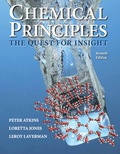
Concept explainers
(a)
Interpretation:
The osmotic pressure of
Concept Introduction:
The pressure that is needed to stop the flow of solvent is known as Osmotic pressure.
The osmotic pressure of dilute solution is related to the molar concentration of the solute in the solution. The osmotic pressure can be calculated by using the following equation:
(a)
Explanation of Solution
Given,
The osmotic pressure can be calculated as follows:
The osmotic pressure of
(b)
Interpretation:
The osmotic pressure of
Concept Introduction:
Refer to part (a).
(b)
Explanation of Solution
Given,
The osmotic pressure can be calculated as follows:
The osmotic pressure of
(c)
Interpretation:
The osmotic pressure of a saturated aqueous solution of
Concept Introduction:
Refer to part (a).
(c)
Explanation of Solution
Given, aqueous solution of
The molarity of the AgCN has to be calculated to calculate the osmotic pressure of the solution.
The osmotic pressure can be calculated as follows:
The osmotic pressure of aqueous solution of
Want to see more full solutions like this?
Chapter 5 Solutions
EBK CHEMICAL PRINCIPLES
- The mole fraction of sodium chloride, NaCl, in a saturated aqueous solution is 0,220. What is the molarity (molar concentration) of this solution if it has a density of 1,150 g.cm–3?arrow_forwardThe average concentration of chloride ion in seawater is 19.353g Cl-/kg. The world health organization recommends that the concentration of Cl- ions in drinking water not exceed 250ppm. How many times as much chloride ion is there in seawater than in maximum concentration allowed in drinking water?arrow_forwardThe solubility of an ionic solid in water is quantified by this expression: Ksp Kc Keq Ka or Kbarrow_forward
- Given that the value of Kf for water is 1.86°C/m, what is the freezing point of an aqueous solution of NaCl (58.45 g/mol) prepared by mixing 427.0 g solute with 1.000 kg of water?arrow_forwardCalculate the equilibrium concentration of carbon dioxide in fat given that the Henry's law constant is 8.6 x 104 Torr and the partial pressure of carbon dioxide is 55 kPa.arrow_forwardHow many (a) millimoles, (b) milliequivalents, and (c) milliosmoles of calcium chloride (CaCl2 . 2H2O; MW: 147) are represented in 147 mL of a 10% w/v calcium chloride solution?arrow_forward
- Determine the vapor pressure of benzyl alcohol at 462.3 K in Pa.arrow_forwardA student using a calibrated solution calorimeter measured a temperature decrease of 1.10 K when 1.00 g of KNO3 was added to 74.40 g of deionized water in the calorimeter. The specific heat capacity of the solution calorimeter was found to be 4.15 J/gK. Calculate the experimental value of the molar heat of solution of KNO3, ΔH soln. Was the dissolution of this salt exothermic or endothermic?arrow_forwardDescribe the general features of the Debye-Huckel theory of electrolyte solutions. Which approximations limit its reliability to very low concentrations?arrow_forward
- What partial pressure of hydrogen results in a molar concentration of 1.0 mmol dm-3 in water at 25 °c?arrow_forwardβ‑Galactosidase (β‑gal) is a hydrolase enzyme that catalyzes the hydrolysis of β‑galactosides into monosaccharides. A 0.490g sample of β‑galactosidase is dissolved in water to make 0.145 L of solution, and the osmotic pressure of the solution at 25 ∘C is found to be 0.719 mbar. Calculate the molecular mass of β‑galactosidase?arrow_forwardWhat is the enthalpy of the dissociation for 2CH4+ O=O = 2CH3OH?arrow_forward
 Chemistry: Principles and PracticeChemistryISBN:9780534420123Author:Daniel L. Reger, Scott R. Goode, David W. Ball, Edward MercerPublisher:Cengage Learning
Chemistry: Principles and PracticeChemistryISBN:9780534420123Author:Daniel L. Reger, Scott R. Goode, David W. Ball, Edward MercerPublisher:Cengage Learning Chemistry: The Molecular ScienceChemistryISBN:9781285199047Author:John W. Moore, Conrad L. StanitskiPublisher:Cengage Learning
Chemistry: The Molecular ScienceChemistryISBN:9781285199047Author:John W. Moore, Conrad L. StanitskiPublisher:Cengage Learning Chemistry & Chemical ReactivityChemistryISBN:9781337399074Author:John C. Kotz, Paul M. Treichel, John Townsend, David TreichelPublisher:Cengage Learning
Chemistry & Chemical ReactivityChemistryISBN:9781337399074Author:John C. Kotz, Paul M. Treichel, John Townsend, David TreichelPublisher:Cengage Learning


